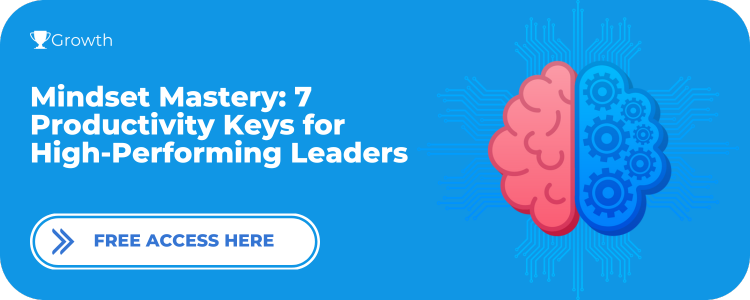✅ FREE ACCESS: Mindset Mastery: 7 Productivity Keys For High-Performing Leaders
Have you ever felt caught in endless tasks, struggling to stay on track in an overwhelming storm of responsibilities?
Well, that might sound overly dramatic.
But what if I told you there are three game-changing solutions that can rescue you from that overwhelming chaos of endless tasks and empower you to conquer it?
Today, we’re going to learn how Precision Planning, Efficient Prioritization, and Successful Delegation can transform overwhelming tasks into thriving ventures.
But before we get into it, make sure you grant your lifetime access to our free Workbook: Mindset Mastery: 7 Productivity Keys for High-Performing Leaders.
This is your chance to make the mindset shift you need to conquer overwhelming storms of tasks by using the 7 mindset keys of the 1% top-performing leaders.
3 Game-Changing Solutions to Escape Overwhelming Situations
Feeling overwhelmed seems natural when facing complex, difficult, or unsettled tasks.
But is it, really?
Let’s walk through a journey where precision planning, efficient prioritization, and successful delegation light your path to escape that quasi-overwhelming feeling and empowers you to push forward, especially when it seems impossible.
This is a plan to create an achievement symphony where science meets strategy and wisdom combines with action.
Precision Planning
The first game-changing solution if you’re feeling overwhelmed by too many tasks is Precision Planning.
Precision planning isn’t just another time management technique. It’s a holistic strategy that leverages our cognitive capabilities to align tasks with goals.
It’s not about doing more. It’s about doing what truly matters.
Everything starts with Critical Path Mapping.
Critical Path Mapping
Critical Path Mapping is based on the assumption that not all tasks are created equally, and on a daily basis, not everything you do is necessarily rooted in your goals.
Getting lost in an ocean of endless tasks is more common than people like to admit.
To create a Critical Path Map, break your goals into key tasks that can be accomplished in a shorter timeframe than the goal.
A successful map must have 3 tasks per goal.
If you struggle to think of 3 related tasks to a given goal, it means that the goal is weak or away from your mission.
If you feel that 3 tasks are not enough, it means that the goal is unlikely to be completed in the current state of events.
To get your Critical Path Mapping:
- Eliminate weak goals.
- Eliminate complex goals.
The Critical Path Mapping is made of the remaining goals that survive that iteration.
Time Distillation
Once you have the Critical Path Mapping done, the next step is Time Distillation which is accomplished by assigning timeframes to each task related to their goals.
That will give you a plausible timeframe for goal completion, instead of a guess.
Why Time Distillation is part of Precision Planning? Because most of the time, feeling overwhelmed by tasks is a direct consequence of bad time management.
Without time management, task cumulate, overdue, and get out of control.
Efficient Prioritization
The second game-changing solution if you’re feeling overwhelmed by too many tasks is Efficient Prioritization.
Once you have established your Precision Planning, It’s time to allocate energy to accomplish the tasks leading to goals.
Establish Deliverables
Begin with establishing the deliverables of each task. These are not things you must do. Deliverables are substantial items you achieve by working on a particular task.
Deliverables are the end point of your task. They mark where the task should be abandoned.
And I say abandoned because tasks are never completed. You have to abandon them at some point and move to something else.
That point is the substantial achievements we’re calling deliverables.
Impact Assessment
With the deliverables of tasks set, you will be able to perform an Impact Assessment and determine which deliverable has more potential to fulfill the task.
That’s what Efficient Prioritization means. Do more with less.
To easily navigate through this process, I suggest using an Eisenhower Matrix.
In the Mindset Mastery Workbook available in the description, you will learn what an Eisenhower Matrix is and a step-by-step process to integrate it into your prioritization process.
By granting your Free Lifetime Access now, you have access to all future updates at no cost.
Resource Allocation
With the Impact Assessment done, it’s time to allocate your resources to optimize accomplishment rhythm.
In the book Thinking, Fast and Slow, Daniel Kahneman highlights the cognitive cost of context-switching.
He explains that when we shift our attention from one task to another, there’s a mental rubble that remains from the previous task.
This rubble can damage our focus and cognitive performance when we engage in the next task.
On the other hand, by focusing on similar tasks, we can establish a cognitive rhythm that enhances our ability to concentrate and minimizes the mental fatigue caused by context-switching.
Resource Allocation for Efficient Prioritization takes that into consideration.
With the Eisenhower Matrix priorities set, you will have a clear prioritization schema to allocate energy efficiently.
Successful Delegation
The third game-changing solution if you’re feeling overwhelmed by too many tasks is Successful Delegation.
What we’re calling Successful Delegation is something that transcends the mere act of outsourcing tasks.
It’s about strategically entrusting tasks to capable hands, amplifying collective productivity, and nurturing a culture of empowerment.
In the Efficient Prioritization stage, we talked about using the Eisenhower Matrix to establish your resource allocation.
It will tell you exactly which tasks you need to delegate and why.
The tasks under the delegation quadrant are the ones you should assign to team members.
Failing in identifying which tasks should be delegated will doom the whole delegation idea.
Strength Identification
Another common reason why leaders fail to delegate tasks, even when they have the proper tasks assessed, is that they don’t consider team members’ natural strengths and inclinations.
The Big Five Personality Assessment is a widely used psychological framework for understanding human personality.
It categorizes personality traits into five broad dimensions: Openness, Conscientiousness, Extraversion, Agreeableness, and Neuroticism (often abbreviated as OCEAN).
These dimensions capture different aspects of an individual’s personality, providing a structured way to measure and describe various traits that contribute to an individual’s behavior, thoughts, and emotions.
Without knowing team members’ personalities, delegation becomes a product of mere luck.
Effective Communication
Let’s say you passed that stage and you have a clear high-level vision of your team’s profile.
Now, you have to make sure you can communicate clearly.
To do that, you need to consider the 7 elements of communication: Source, Message, Channel, Receiver, Feedback, Environment, and Interference.
A full effective communication strategy is beyond the scope of today’s content, but here are 3 fundamental principles to keep your mind around:
- The Source is responsible for communication success.
- As such, The Source must account for the message, channel, and environment where communication can effectively reach its intended Receiver.
- The Receiver, on the other hand, is responsible for providing feedback so the Source can update the message, channel, or reconsider the environment to prevent Interference.
That makes Successful Delegation more than just transactional. It makes it transformational because It depends on trust, collaboration, and synergy, giving shape to Stephen Covey’s ethos of “win-win”.




